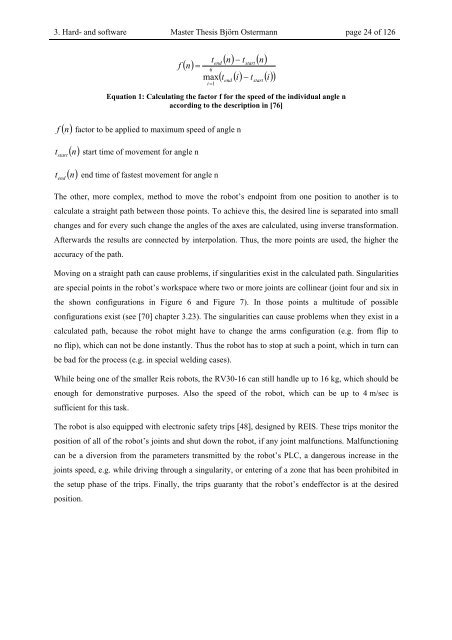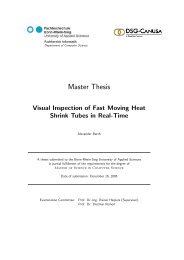Master Thesis - Hochschule Bonn-Rhein-Sieg
Master Thesis - Hochschule Bonn-Rhein-Sieg
Master Thesis - Hochschule Bonn-Rhein-Sieg
You also want an ePaper? Increase the reach of your titles
YUMPU automatically turns print PDFs into web optimized ePapers that Google loves.
3. Hard- and software <strong>Master</strong> <strong>Thesis</strong> Björn Ostermann page 24 of 126<br />
f<br />
�n� t<br />
�<br />
max<br />
end<br />
6<br />
i �1<br />
�n� � tstart<br />
�n� �t�� i � t �� i �<br />
end<br />
Equation 1: Calculating the factor f for the speed of the individual angle n<br />
according to the description in [76]<br />
f �n� factor to be applied to maximum speed of angle n<br />
tstart �n� start time of movement for angle n<br />
tend �n� end time of fastest movement for angle n<br />
The other, more complex, method to move the robot’s endpoint from one position to another is to<br />
calculate a straight path between those points. To achieve this, the desired line is separated into small<br />
changes and for every such change the angles of the axes are calculated, using inverse transformation.<br />
Afterwards the results are connected by interpolation. Thus, the more points are used, the higher the<br />
accuracy of the path.<br />
Moving on a straight path can cause problems, if singularities exist in the calculated path. Singularities<br />
are special points in the robot’s workspace where two or more joints are collinear (joint four and six in<br />
the shown configurations in Figure 6 and Figure 7). In those points a multitude of possible<br />
configurations exist (see [70] chapter 3.23). The singularities can cause problems when they exist in a<br />
calculated path, because the robot might have to change the arms configuration (e.g. from flip to<br />
no flip), which can not be done instantly. Thus the robot has to stop at such a point, which in turn can<br />
be bad for the process (e.g. in special welding cases).<br />
While being one of the smaller Reis robots, the RV30-16 can still handle up to 16 kg, which should be<br />
enough for demonstrative purposes. Also the speed of the robot, which can be up to 4 m/sec is<br />
sufficient for this task.<br />
The robot is also equipped with electronic safety trips [48], designed by REIS. These trips monitor the<br />
position of all of the robot’s joints and shut down the robot, if any joint malfunctions. Malfunctioning<br />
can be a diversion from the parameters transmitted by the robot’s PLC, a dangerous increase in the<br />
joints speed, e.g. while driving through a singularity, or entering of a zone that has been prohibited in<br />
the setup phase of the trips. Finally, the trips guaranty that the robot’s endeffector is at the desired<br />
position.<br />
start














